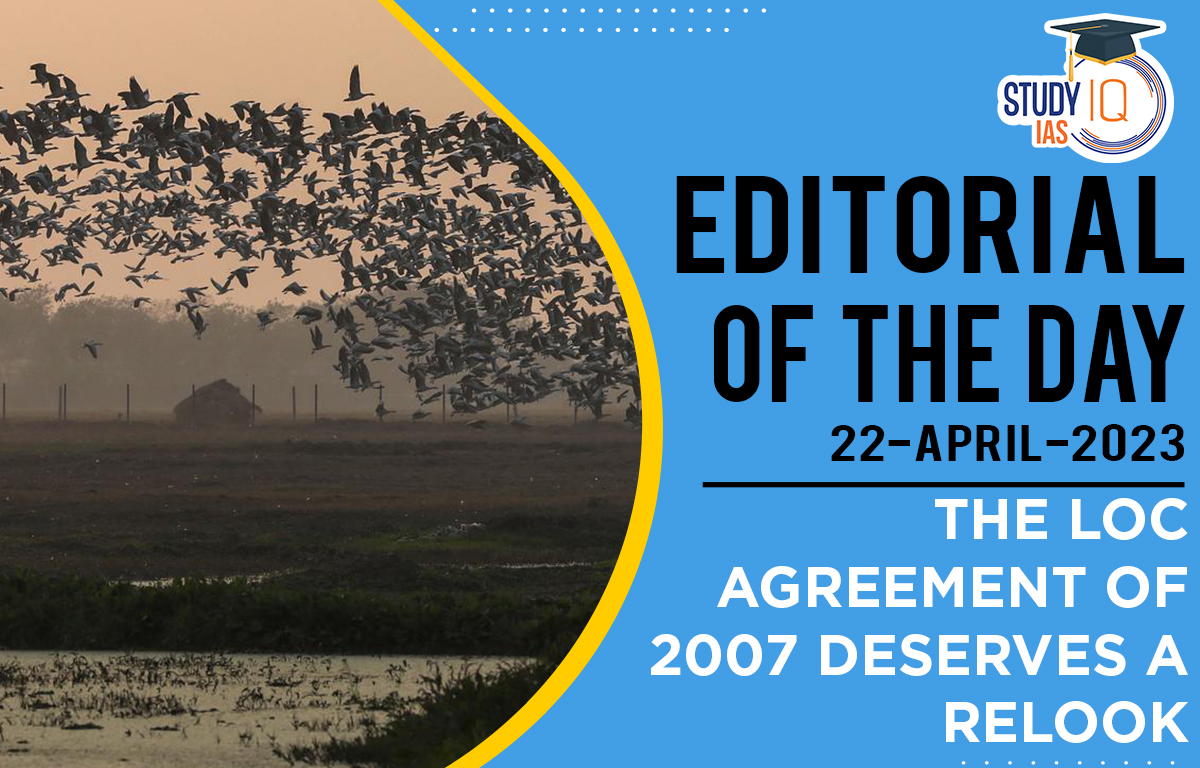Table of Contents
Context: The article is discussing a stalled agreement on the Line of Control (LoC) in Kashmir that was to be signed by then-Prime Minister of India, Manmohan Singh, and the Pakistan President General Musharraf. It highlights that the efforts to revive it were effectively halted due to the stand-off with the judiciary in Pakistan in 2007 and the Mumbai 26/11 attacks in 2008.
The LoC Agreement of 2007 Deserves a Relook Background
Line of Control:
- The Line of Control (LoC) is a military control line that separates the Indian-administered union territory of Jammu and Kashmir from the Pakistan-administered area of Gilgit-Baltistan.
- It came into existence after the first India-Pakistan war in 1947-48, when the UN brokered a ceasefire agreement between the two countries.
- The ceasefire line was later designated as the LoC in 1972 after the Shimla Agreement, which was signed by the Indian and Pakistani governments.
Shimla Agreement:
- The Shimla Agreement, signed in 1972 between India and Pakistan, aimed at resolving the conflict between the two countries over the state of Jammu and Kashmir.
- The agreement was signed by Indian Prime Minister Indira Gandhi and Pakistani President Zulfikar Ali Bhutto after the 1971 Indo-Pakistan war that resulted in the creation of Bangladesh.
- Key provisions of the Shimla Agreement included:
- The designation of the ceasefire line of December 17, 1971, as the new “Line-of-Control (LoC)” between the two countries, which neither side is to seek to alter unilaterally.
- The agreement also called for both countries to put an end to the conflict and confrontation and work towards establishing a durable peace in the subcontinent.
- It stated that any disputes between India and Pakistan would be settled by peaceful means through bilateral negotiations.
Ceasefire Agreements between India and Pakistan on LoC:
Since independence, there have been several ceasefire agreements between India and Pakistan relating to the LoC.
- Karachi Agreement: The first such agreement was signed on January 1, 1949, between India and Pakistan, which established a ceasefire line that was supervised by the UN. The ceasefire agreement included provisions for a plebiscite to be held in Jammu and Kashmir to determine its future status.
- Tashkent Declaration: In 1965, India and Pakistan fought their second war over Kashmir, which ended in a UN-mandated ceasefire. The Tashkent Declaration was signed in 1966 to restore diplomatic and economic relations between the two countries and to withdraw to pre-war lines.
- Shimla Agreement: In 1971, India and Pakistan fought their third war over East Pakistan (now Bangladesh) and the Shimla Agreement was signed in 1972 to establish the LoC as a permanent ceasefire line between the two countries.
- Lahore Declaration: In 1999, the Kargil War was fought between India and Pakistan along the LoC. The conflict was resolved with the intervention of the international community, and the two countries signed the Lahore Declaration in February 1999, pledging to resolve all issues including Kashmir through dialogue.
- Ceasefire Agreement of 2003: The agreement prohibits ceasefire violations along the LoC and the Working Boundary, and includes mechanisms for communication and coordination between the military authorities of the two countries.
Other Areas of Friction between India and Pakistan:
- Indus Water Treaty: It is an agreement between India and Pakistan that was signed in 1960 with the intervention of the World Bank.
- It allocated three western rivers (Jhelum, Chenab, and Indus) to Pakistan, while India was given control over the three eastern rivers (Ravi, Beas, and Sutlej).
- Dissatisfaction with IWT:
- India’s view is that IWT prevents the country from building any storage systems on the western rivers and that
- Pakistan’s view is that it objects to Indian claims of not utilizing the share of water in Western rivers, and that construction of storage dams would not abrogate the treaty.

- Cross Border Terrorism:
- International Sanctions and Terrorist Groups: India has attempted to have leaders of the terrorist groups put on the UN list of proscribed terrorists, but China has blocked this designation with a technical hold.
- Terrorist Attacks: The Mumbai attack of 2008, Pathankot Airbase Attack in 2016, the Uri attack are all instances of deadly terror attacks.
- Sir Creek Dispute: Sir Creek is a strip of water that spans across 96 km in the Rann of Kutch marshlands, disputed between India and Pakistan.
- The dispute lies in the interpretation of the maritime boundary line between Kutch and Sindh.
- Before India’s independence, the region was a part of the Bombay Presidency of British India. But after India’s independence in 1947, Sindh became a part of Pakistan while Kutch remained a part of India.
- Pakistan claims the entire creek while India claims that the boundary lies midchannel.
- Sir Creek is considered to be among the richest fishing grounds in Asia. Additionally, there is a possibility of great oil and gas concentrations under the sea, which are currently unexploited due to the deadlock on the issue.
- Dispute over Siachen:
- The dispute over the Siachen glacier and the adjoining areas between India and Pakistan is primarily due to their divergent positions.
- The ceasefire line, established in an agreement after the 1947-1948 war, did not provide a clear delineation beyond grid reference NJ9842.
- While Pakistan interprets this as a line proceeding straight to the Karakoram pass on the Sino-lndian border, India insists that it should proceed north along the Saltoro range to the border with China.
- CPEC: The route passes through the disputed Kashmir region, which is under illegal occupation by Pakistan. India’s opposition to CPEC reflects a concern over the internationalisation of the Kashmir dispute, the growing influence of China in the Indian Ocean, and the sovereignty issue.
Decoding the Editorial
The article talks about an agreement between India and Pakistan that seeks to establish a “normal border” between the two countries without redrawing their existing borders.
- Objective of the Agreement:
- This agreement includes a set of guidelines for any settlement between the two countries, such as a free flow of trade, ending cross-border terrorism, respect for human rights, and reducing military presence on both sides of the Line of Control (LoC) in Kashmir.
- The idea behind this agreement is that the LoC should be respected like any other normal border between two countries.
- Hardships in resolving India-Pakistan Conflict: There are a number of challenges and obstacles that stand in the way of achieving a resolution between India and Pakistan, particularly in regards to the proposed agreement on a “normal border” between the two countries.
- Many of the key players involved in the talks from 2003-2008 have either passed away or are no longer in power, which makes it difficult to revive the process.
- Additionally, a series of terror attacks, such as the ones in Mumbai, Pathankot, and Pulwama, have created a sense of mistrust and made it difficult for India to engage in any dialogue with Pakistan.
- Furthermore, the reorganization of Jammu and Kashmir by the Indian Government has caused certain hindrances in the restoration of ties.
- As a result, there is currently no political contact, trade, or direct travel links between the two countries, and no High Commissioners in each other’s countries, which further exacerbates the challenges in resolving the conflict.
- Back Channel Diplomacy:
- The back-channel focuses on preventing hostilities between the two countries, and has been used in various instances such as the post-Balakot downing of an Indian Air Force pilot in Pakistan in 2019, the LoC ceasefire agreement of 2021, and the aftermath of a live missile accidentally launched into Pakistan by the Indian Air Force in March 2022.
- The back-channel plays a significant role in preventing escalations and hostilities between India and Pakistan, and shows that despite the lack of official engagement between the two countries, there are still channels of communication and efforts to maintain peace.
- Suggested solutions to Restore Normalcy:
- Corridors of Engagement: In 2018, the ceremony of the Kartarpur Corridor was held following the government of India’s approval to open a visa-free corridor for Indian Sikh pilgrims to visit Gurdwara Kartarpur Sahib in Pakistan. The corridor is a good confidence-building measure between the two countries and would improve people to people contacts.
- “Sharda Peeth Corridor” and other additional corridors between the two nations can enhance people-people engagement.
- Holding elections in Jammu and Kashmir, reappointing High Commissioners, and restoring visas and people-to-people ties between the two countries.
- Revisiting a nearly-ready agreement that was legally vetted 15 years ago.
- Pakistan’s severed trade and travel links shall be revived through negotiations and agreements.
- A settlement based on the idea of the Line of Control being respected like a normal border between the two countries, which was proposed in the earlier agreement, should be made feasible.
- Radical measures such as arrests of political and civil society leaders, internet bans, and human rights violations in the strategically sensitive area should be under control.
- Ending cross-border terrorism from Pakistan, which has caused suffering for the people of Jammu and Kashmir for decades, including the Kashmiri Pandit community.
- Any military operation by either India or Pakistan to reclaim the other side should be avoided and “status quo” has to be maintained to avoid a two-front military engagement and a possible threat from China at the Line of Actual Control that is more likely to continue to be India’s bigger challenge.
- A bilateral agreement enforcing all the above should be signed by both sides.
- Corridors of Engagement: In 2018, the ceremony of the Kartarpur Corridor was held following the government of India’s approval to open a visa-free corridor for Indian Sikh pilgrims to visit Gurdwara Kartarpur Sahib in Pakistan. The corridor is a good confidence-building measure between the two countries and would improve people to people contacts.
Beyond the Editorial
Areas of Cooperation between India and Pakistan
- Commercial Relations: The commercial relations between India and Pakistan are significantly affected by the changing political environment.
- The main items of export from India to Pakistan include cotton, organic chemicals, machinery, food products including prepared animal fodder, vegetables, plastic articles, man-made filament, coffee, tea and spices, dyes, oil seeds and olea, etc.
- On the other hand, the main items of import by India from Pakistan are copper and copper articles, fruits and nuts, cotton, salt, sulphur and earths and stones, organic chemicals, mineral fuels, rubber plastic products, wool, etc.
- People-to-People Contacts:
- The revised Visa Agreement of September 2012 has led to the liberalization of the existing bilateral visa regime and resulted in increased people-to-people contact.
- This Agreement has liberalized provisions concerning “Business Visas”.
- It introduced “Visa on Arrival” at Attari/Wagah border for nationals above 65 years of age and “Group Tourist Visa”.
- The new provisions allow bonafide business persons Visas with multiple entries and travel in India up to 10 cities for business purposes.
- Additionally, the groundbreaking ceremony of the Kartarpur Corridor was held in November 2018 following the Indian government’s approval to open a visa-free corridor for Indian Sikh pilgrims to visit Gurdwara Kartarpur Sahib in Pakistan.


 Question Hour in Parliament: Meaning, Ty...
Question Hour in Parliament: Meaning, Ty...
 Daily Quiz 18 July 2025
Daily Quiz 18 July 2025





















